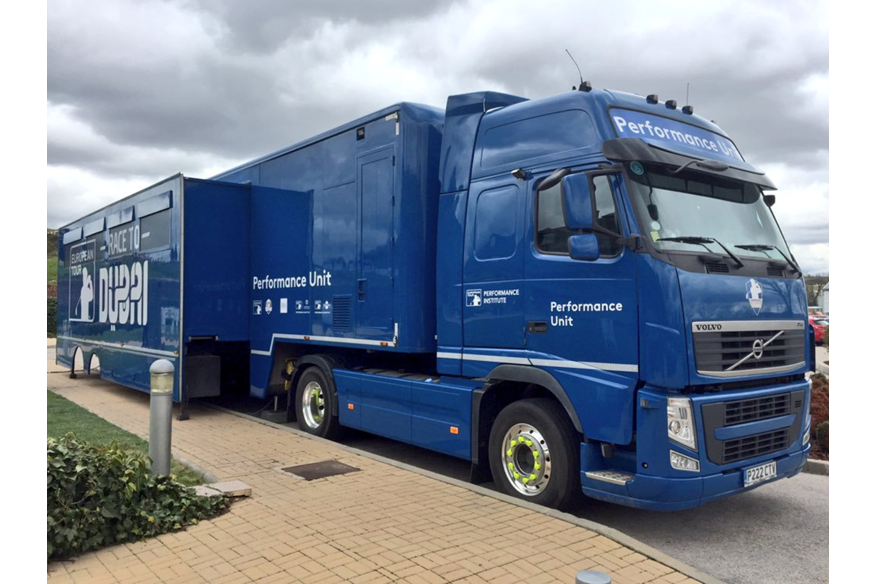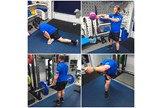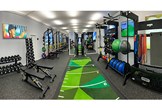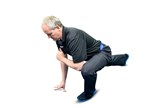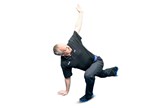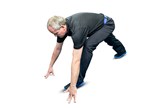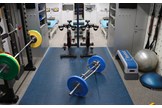Inside the European Tour’s fitness and wellness truck
Published:
Inside the European Tour’s fitness and wellness truck
When the European Tour’s physiotherapy unit was first founded in 1992, the idea of warming up, working out, and devoting half an hour to recovery after 18 holes was little more than an afterthought for most golfers.
“When I first turned pro, I was the only one in the gym, except Vijay [Singh],” Tiger revealed earlier this year. “Now, everyone trains. Everyone works on their bodies, besides their game, and hey, even Phil [Mickelson] is working out! Things have come a long way.” Rob Hillman can testify to that, having started volunteering for the European Tour in an era where players favoured drinking sessions over gym sessions and were derided for being non-athletes.
“The ‘Tiger effect’ changed everything,” says Hillman, who left the NHS to join the European Tour full-time as a physiotherapist in the early noughties. Changing attitudes towards health, fitness and wellbeing mean it’s now not uncommon to see more than 100 players working out or requesting treatment on the physio truck on any given day. Hillman now acts as a director of the Physiotherapy Unit and Performance Institute, and heads up a team of physiotherapists, osteopaths, chiropractors and sports therapists who travel 30,000km a year across Europe, Asia and even into Africa.
The hard part, Hillman admits, is getting the truck – which doubles as a gym and medical practice at tournaments – from A to B. It is his job to manage the organisation and logistics and while he holds an HGV licence, he has long since handed over the driving duties. He points out that he spends enough time on the mobile unit anyway – 12 hours a day in some cases – to ensure members on the European Tour, Challenge Tour and Staysure Tour have access to the best medical care and performance services possible.
He shares the same space with Dr Andrew Murray, chief medical officer for the European Tour and Ryder Cup Europe, who he reckons might be the fittest man on tour. It is Murray’s job to look after “all medical aspects, performance nutrition and sports science”, and help up to 156 players eat, sleep and perform like a champion every single week. It does mean he’s rarely off duty, which is why we booked an appointment with him and Hillman at the British Masters to find out exactly what goes on behind closed doors…
Jump to >> The World’s greatest stretch
WHAT DO YOUR ROLES INVOLVE?
RH: Day to day, I’m heading up and managing the performance unit. I look after the therapy services, so we have a number of different practitioners, physiotherapists, osteopaths, chiropractors, sports therapists, and a strength and conditioning service. It’s a free walk-in service for all the players
at an event. Basically, we look to coordinate that service with sports medicine, so we have a number of other specialists that we work with now that come out to certain events, like radiologists and wrist specialists. We also work with nutritionists and anti-doping. As a player service, we are looking to provide world-class leading services for the players that is evidence based and evidence backed. I think it’s 77 events we are covering across the three tours this year.
AM: I’m a medical doctor, so I’ve worked for various different professional sports organisations. I’ve worked at the Olympic Games, Paralympic Games, Commonwealth Games, The Institute of Sport and Scottish Rugby. I’ve also worked for the Scottish government promoting health and wellbeing and all the bene ts that physical activity can bring. It was a great honour to come and join the European Tour performance team five or six years ago, and over the last couple of years we’ve looked to develop the service so that it’s a really holistic service. It’s not just looking at injuries when they do occur, but it’s being really proactive. How can we help these guys flourish? How can we help them to be at their very best? The difference between first and fourth in the Olympics is 0.4 of one per cent. The difference between first and second in The Open and at the BMW PGA Championship is one shot. Again, that’s one third of one percent, so how can we contribute and add value in that space?
WHAT KIND OF TECHNOLOGY AND KIT IS AVAILABLE ON THE TRUCK?
RH: We have some great strength and conditioning tools. We had a dedicated squat rack put in, which is quite a unique facility for a mobile unit. We have about 200 kilos of plated weight that the players are able to access. We have a couple of warm-up bikes and a gym wall where they can do various bits of resistance and balance mobility-type training. We have certain items of therapy usage, so we have a shockwave device that’s quite good at treating tendon issues and is a useful piece of equipment. And I think our hands are probably pretty useful.

WHAT TYPE OF SCANNING EQUIPMENT DO YOU HAVE ON SITE?
AM: The players need maximum convenience so we’ve got a portable ultrasound that will ask questions, examine a patient, and work out exactly what’s going on for that player. We’ve seen six or seven players already today with left wrist issues because it’s something that’s really common. But rather than punting them o to the nearest hospital for an MRI 40 minutes away, our dynamic scanning can give them an answer straight away, and then we can put treatment in place with our strength and conditioning [team], with our physio and with our doctor colleagues. Again, it’s just making a really accurate diagnosis as convenient as possible for the player.
RH: To have access to dedicated equipment like that, where you can do instant scans and reveal soft tissue injuries, which are quite prevalent, is a fantastic facility to have. It can help guide us with treatment, prognosis, how long people might be out for, and
it can guide us with injections so we can really target specific tissues. That’s the most interesting part of the medical services.
WHAT ARE THE MOST COMMON INJURY COMPLAINTS IN GOLF?
AM: We conducted a review to see what are the most common injuries that professional golfers get and they are actually very different to the injuries that amateur golfers get. The most common injuries we see are back injuries, so lumbar spine issues, neck injuries and left wrist injuries in a right-handed golfer. These are the injuries you see in the professional golfer. Amateur golfers are obviously subject to some of the same issues in the spine, but you see a lot more elbow injuries and a lot of injuries relating to swing technique, rather than overload-type injuries, that we tend to see in the professionals.
ARE THERE ANY EXERCISES OR RESISTANCE MACHINES GOLFERS SHOULD STAY AWAY FROM?
RH: I don’t necessarily think there are any bad exercises; I think the important thing is exercise choice and that really depends on an individual assessment of a person’s capabilities, and what their goals are. That’s very, very important. The key factors we are looking at, in particular, are speed and strength which are two great qualities you need in the goal swing. It’s really important that the training reflects those targets to get maximum input and feedback in terms of improvement. Regarding exercise choice, people might have restrictions in certain areas or may not like to do particular movements. We’ve seen some of the Olympic lifts in weight lifting that involve a lot of wrist movement and as the wrist is quite a sensitive area in golf, if a player has a history of wrist injuries we wouldn’t necessarily advocate doing a lot of wrist-based overhead pressing.
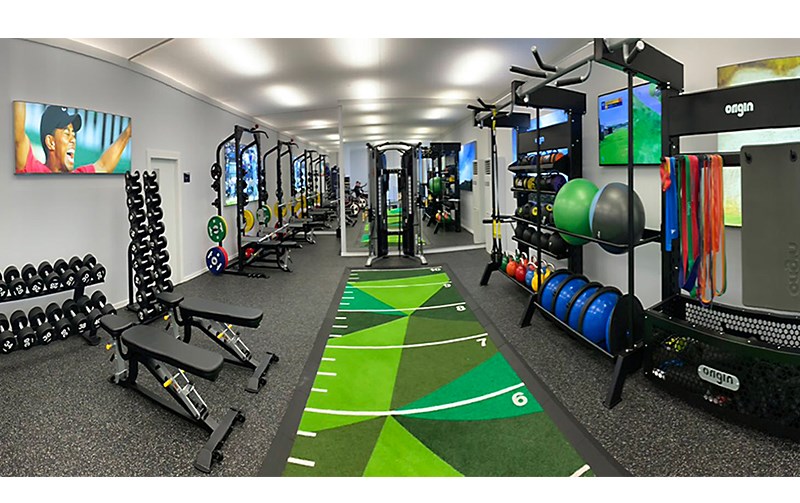
HOW LONG DO PLAYERS TYPICALLY SPEND ON THE TRUCK?
RH: It really depends on what they are looking to achieve. If it’s morning time, 20 minutes to half an hour in terms of getting some mobility, and really looking to re up the muscles they are going to be using. If they are coming back in the day and training, it can be up to 45 minutes to an hour. I don’t think we’d ever see people doing more than an hour-long session because they have very long days, are up early, and spend a lot of time practising. We are also looking to get real ‘bang for buck’ in terms of the time that’s available. With some of the simple exercises like squats and deadlifts, you actually don’t need much to do really high intensity strength training. We’re talking four sets of four repetitions. Quite often, that’s enough to keep people ticking over a couple of times a week.
DO YOU PROVIDE SUPPORT FOR ISSUES SUCH AS ANXIETY AND DEPRESSION?
AM: For players to be at their best, physical health is extremely important but mental health and wellbeing is massively important as well. Twenty per cent of the general population will have mental health and wellbeing issues in any given year, and five per cent of people will have a really significant illness in any given year. As a general practitioner and sports medicine doctor, mental health and wellbeing is such a priority. Golfers are amazing at what they do, but they are also human beings. People think that it’s easy and a really glamorous lifestyle but it’s actually so difficult travelling for 25/30 weeks per year, across multiple time zones and dealing with jet lag and being away from home and loved ones. That can put a fair strain. Issues relating to depression, anxiety and mental health and wellbeing are ones we are keen to support our European Tour, Staysure Tour and Challenge Tour players with. It’s a big part of what we do. It’s much underestimated the benefits that physical activity has for mental health and wellbeing. By being active by playing golf, you are going to decrease the risk of getting depression and anxiety.
WHO ARE YOUR MOST FREQUENT VISITORS ON THE TRUCK?
RH: We have a dedicated group of about 30 per cent of the eld, typically each week, who are doing regular mobility work and strength and conditioning training, and maybe getting some hands-on treatment. And it’s really good to see that people are treating that side of the game with a lot more professionalism. Golf didn’t always have the reputation that golfers were athletes, but if you look at what they are able to do nowadays, we really talk in terms of forces, and force production. So, to be able to swing the club fast and hit the ball a long way, you need to be able to generate speed and you need strength, speed, mobility and stability to be able to do that. It’s really good to see players working on that. There’s been a real change in terms of their fitness levels. Cardiovascular-wise, people are improving but certainly strength- wise there has been a huge change in the last 10 to 12 years.
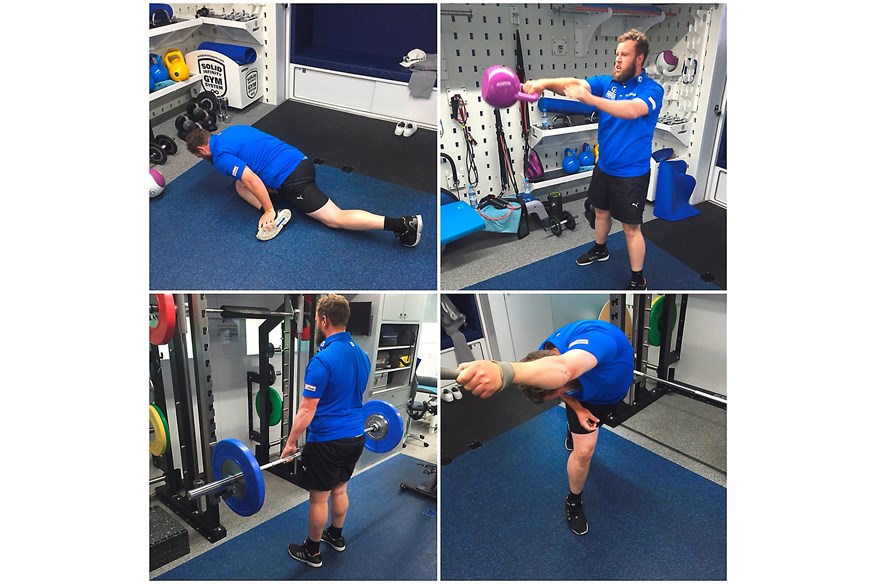
WOULD YOU RECOMMEND INCORPORATING YOGA OR PILATES INTO A WEEKLY ROUTINE TO PREVENT INJURY AND IMPROVE PERFORMANCE?
RH: Most definitely. In terms of the control that you need for something like Pilates, that can reflect very well and pay forwards into the stability that you need in the golf swing.
DO YOU USE DRUGS TO TREAT INJURIES?
AM: Simple things like paracetamol can be effective as a pain relief; sometimes if there’s inflammation that people have got in their back or wrist or shoulder they may take anti- inflammatory medications. They are all permitted in competition, but obviously there are some medications, for example corticosteroids, that are not permitted without a valid exemption that can be secured if necessary. We do advise our players to have a u jab every year, and actually the vast majority of them do get that. You’ll sometimes see people having diarrhoea and vomiting so we need to get on top of that, but we work pretty hard with the hotels and caterers to make sure the standards of hygiene are extremely high.
HOW DO YOU HELP HAY FEVER?
AM: Anti-hay fever tablets can actually help quite considerably. Something like loratadine or cetirizine. One tablet per day can actually help keep your symptoms at bay. Other really simple things are wearing sun shades and washing your hands regularly before you get on the course and after you finish. So essentially if you have got pollen on your hands, you’re not sticking it over your eyes and hands.
WHEN’S YOUR BUSIEST TIME?
RH: Generally, that would be the practice days. There’s probably a pattern that people don’t like to be up too early in the mornings on Tuesdays and Wednesdays. Once the pro-am is established and up and running, I think a period between nine and three is pretty intense. Quite often we’re on the go for most of the day, and it can be fairly early starts: 4.30/5 o’clock. And particularly with something like The Open, a late finish is around about 9.30/10 o’clock at night. We can have upwards of 80 to 100 players through our doors.
HOW IMPORTANT IS NUTRITION NOW?
AM: It’s one of those big concrete things that can make a significant difference. Our head of performance nutrition, Graeme Close, is head of nutrition for England Rugby and various football clubs. So, we are taking information all the time. But it really boils down to a few simple things. It’s about staying well, so eating plenty of fresh fruit and vegetables. Things that are colourful are essentially good for immune function, except for Skittles and Haribo! Your muscles are made of protein, so regular protein can preserve muscle function. Again, it doesn’t matter how good the car is, if there’s no fuel in the tank it’s going nowhere. So, we make sure players are fuelling up before they go on the course and also for the duration of that because often they are out there for five or six hours, missing lunch.
WHAT KIND OF FOOD IS SERVED IN THE PLAYERS’ LOUNGE?
AM: The European Tour really does listen to the players and is a player-led organisation. It works closely with promoters and nutritionists to make sure the offering in the players’ lounge is as good as it can be. Some of the things that are really popular are clear labelling of foods, so knowing where the protein station is, knowing what’s carbohydrates, and knowing what is good for immune function.
DO YOU RECOMMEND THAT PEOPLE LIMIT THEIR CAFFEINE INTAKE?
AM: We are not here to tell players what to do; we are here to give them sensible advice so they can make their own decisions. But in general we can give them the science that suggests that two-to-four coffees per day, or something of that equivalent, might be optimal. It depends as well, because you don’t want to be drinking coffee at 10 o’clock at night because that might interfere with your sleep. If you are a golfer out there, there are simple things that will help significantly to reduce your score and injury risk. Sleep like a champion, eat like a champion, train like a champion. Simple things like doing an eight-minute warm-up can take one-and-a-half shots o your score and half your risk of injury.
DO YOU HAVE ANY WARM-UP TIPS?
RH: A little bit of cardio. So, five to 10 minutes – even very brisk walking or going up and down stairs – will increase the heart rate and get some blood ow into the muscles you’re going to be using. And then things like some bodyweight squats would be really good to try and engage the core, upper limb and lower limb. You can incorporate some overhead squats with the club over your head. Simple movements like that, which involve the whole body, can prepare you as well as swinging the club.
THE WORLD’S GREATEST STRETCH
This is a great routine because it gives you bang for your buck in terms of four different movements with one stretch. With Rob Hillman
1. Extend your left leg into a lunge position and place your right palm on the floor. This stretches the glute on one side and hip flexor on the other. Using your opposite arm, push your elbow into the side of your knee to stretch the abductor.
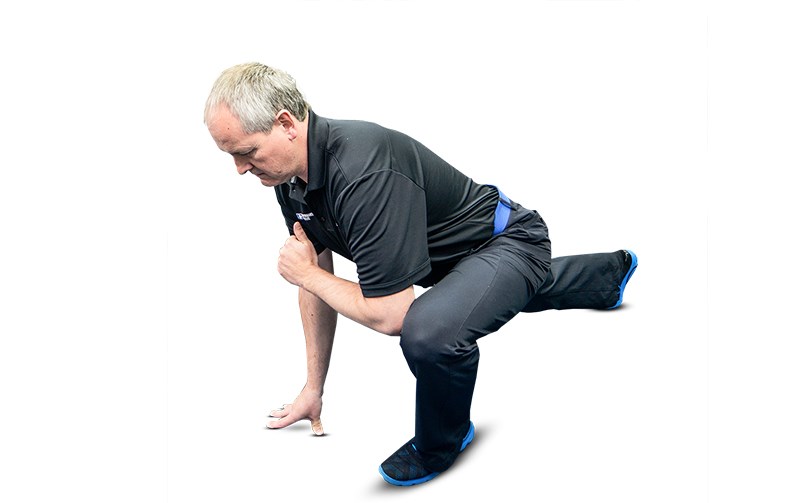
2. Maintaining the same position, stretch the thoracic region by turning your left shoulder and reach up with the left hand pointing towards the ceiling. Hold the position and then repeat for five reps.
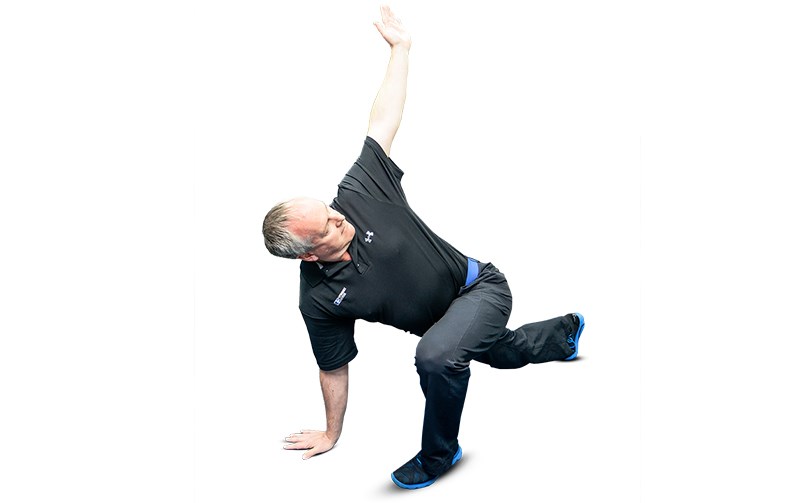
3. Finally, rock back onto the heel of your front foot and into a hamstring stretch, with your fingertips just touching the floor. Return to the starting position and repeat each stage using the opposite leg.
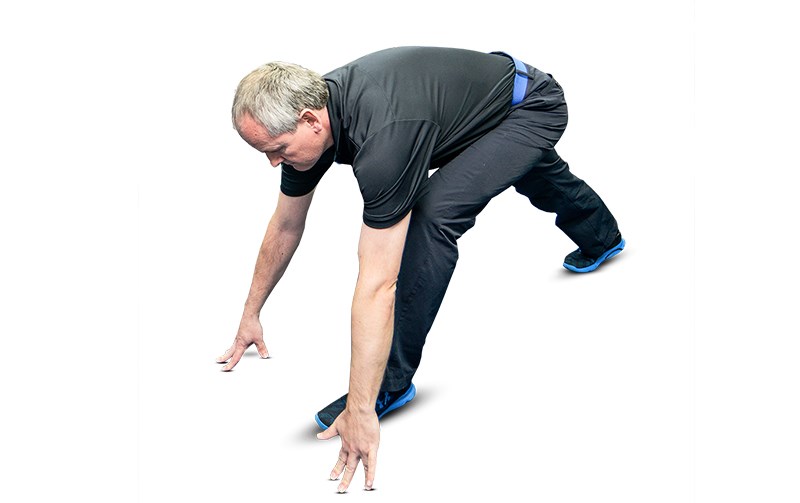
FACT V FICTION
Andrew Murray and Rob Hillman address three big health and wellbeing topics
YOU NEED EIGHT HOURS SLEEP A DAY
One of the best things you can do for health and wellbeing, in general, is to sleep like a champion. It doesn’t matter if you’re trying to win the BMW PGA or if you’re looking to succeed in business or be at your best all of the time. You’re going to be more successful and function better if you have slept for eight hours compared to five. You are actually four and a half times more likely to get ill if you’ve slept five hours on average compared to eight; you’re 1.7 times more likely to get injured if you’ve slept five hours compared to eight.
A TIPPLE THE NIGHT BEFORE CAN CALM YOUR NERVES ON THE FIRST TEE
AM: There’s not been shown to be any performance benefit with alcohol. Like everything else, alcohol would be best in moderation. We would advise folk to keep a bit of a lid on it, but also celebrate success when it does come.
SUN EXPOSURE IS ALWAYS BAD FOR YOU?
Actually, sun exposure can be a really good volume. It can boost the body’s natural vitamin
D levels and that can be really positive in terms of muscle function and immune function. But, again it’s about having the right balance, just the right amount and not too much. It’s about getting yourself 15 or 20 minutes of bright sunshine each day and then on top of that, when you’re on the course, making sure you’ve got high factor sun cream on and clothing to protect your neck and ears.
